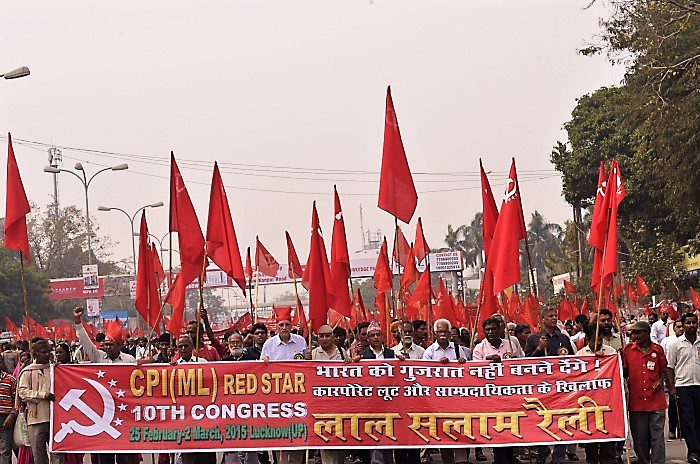Unlike Bengal, other states seem to be less lucky to deal with similar agitations by militant groups and NGOs against development programmes, including infrastructure, industrial and core sector projects, which the country needs desperately to stabilise and grow its economy. In fact, richer states such as BJP-ruled Maharashtra and Gujarat and AIADMK-led Tamil Nadu are faced with more violent demonstrations from militant groups and locals as the government prepares to strengthen and expand the country’ s industry and infrastructure systems. A report, for Different Truths.
Not many people in Bengal may have ever heard the name of an outfit called CPI-ML Red Star, not until it attacked a Power Grid Corporation’s (PGCIL) sub-station project, being built in co-operation with the West Bengal government, at fast developing Rajarhat in Kolkata’s outskirt. The central transmission utility had sought cooperation from all stakeholders for completion of the Rs. 800-crore Rajarhat sub-station project. “Considering advantages of the Rajarhat 400/220kV sub-station project, Power Grid Corp solicits cooperation from all stakeholders,” PGCIL had said in a statement while maintaining that land for the project was acquired at “market rates to adequately compensate locals”. It had also said that “GIS technology is safe, reliable and requires less maintenance…”
 CPI-ML Red Star collected a few thousand people from nearby villages to attack the project, earlier this year. The police tried to control the stone pelting and handmade bomb throwing mob with usual lathi charge and teargas shells, in which several people, including policemen, were injured and one died later in the hospital. The protestors don’t want the transmission project. They want their land back. Thanks to a strong position taken by the overwhelmingly Trinamool-led West Bengal government in support of the project, the work on the sub-station is on. A key leader of the CPI-ML Red Star, responsible for the violent agitation, was arrested recently from an Odisha hide-out. Hopefully, the project will soon be completed.
CPI-ML Red Star collected a few thousand people from nearby villages to attack the project, earlier this year. The police tried to control the stone pelting and handmade bomb throwing mob with usual lathi charge and teargas shells, in which several people, including policemen, were injured and one died later in the hospital. The protestors don’t want the transmission project. They want their land back. Thanks to a strong position taken by the overwhelmingly Trinamool-led West Bengal government in support of the project, the work on the sub-station is on. A key leader of the CPI-ML Red Star, responsible for the violent agitation, was arrested recently from an Odisha hide-out. Hopefully, the project will soon be completed.
However, other states seem to be less lucky to deal with similar agitations by militant groups and NGOs against development programmes, including infrastructure, industrial and core sector projects, which the country needs desperately to stabilise and grow its economy. In fact, richer states such as BJP-ruled Maharashtra and Gujarat and AIADMK-led Tamil Nadu are faced with more violent demonstrations from militant groups and locals as the government prepares to strengthen and expand the country’ s industry and infrastructure systems. Deadly disputes are brewing in several other parts of the country over land and environment as the world’s second most populous country gears up for the next level of development.
 Since last month, India’s largest copper smelter, operated by Vedanta Resources, at Tamil Nadu’s port city of Thoothukudi, remained shut down after the Tamil Nadu police fired a large group of violent agitators, killing 13 people and injuring at least 50. Activists have been agitating against the unit saying emissions from the plant were polluting the air, water, and soil, affecting people’s health and livelihoods. Vedanta denied the allegations. The company said in a statement that it had complied with “all the necessary regulations”. The state didn’t support Vedanta management in the face of public ire. Finally, it was shut down by a court order. In Gujarat, farmers have taken to the streets to protest against land acquisitions for a US$ 17-billion bullet train project under Japanese collaboration. Farmers, who stand to lose 850 hectares of land, have not given their consent for land acquisition.
Since last month, India’s largest copper smelter, operated by Vedanta Resources, at Tamil Nadu’s port city of Thoothukudi, remained shut down after the Tamil Nadu police fired a large group of violent agitators, killing 13 people and injuring at least 50. Activists have been agitating against the unit saying emissions from the plant were polluting the air, water, and soil, affecting people’s health and livelihoods. Vedanta denied the allegations. The company said in a statement that it had complied with “all the necessary regulations”. The state didn’t support Vedanta management in the face of public ire. Finally, it was shut down by a court order. In Gujarat, farmers have taken to the streets to protest against land acquisitions for a US$ 17-billion bullet train project under Japanese collaboration. Farmers, who stand to lose 850 hectares of land, have not given their consent for land acquisition.
 In Maharashtra, the fate of the proposed $44-billion refinery and petrochemical complex, the largest in India, hangs in balance, following agitations by the locals and environmentalists. Thousands of farmers are refusing to surrender the coastal area land for the project that is to be implemented by a consortium of three Indian public sector oil companies — IOC, BPCL and HPCL — and global oil giant Saudi Aramco. The project will require some 15,000 acres of land. The region is famous for its juicy Alphonso mangoes and lush cashew plantations. All the 10 village panchayats in the vicinity have reportedly passed resolutions opposing the land acquisition process. The local people fear that the project will not only displace them but also kill the mango and cashew cultivation apart from causing irreparable damage to palm trees and marine life. Shiv Sena and MNS have thrown their weight behind the protesters. Such conflicts are increasing across the country. A large number of new projects, including roads, airports and seaports, rail transit systems, telecommunications, petroleum refining and pipeline transportation, coal and mining, electricity generation and transmission, among others, may be delayed and some even abandoned if those violent agitators have their way.
In Maharashtra, the fate of the proposed $44-billion refinery and petrochemical complex, the largest in India, hangs in balance, following agitations by the locals and environmentalists. Thousands of farmers are refusing to surrender the coastal area land for the project that is to be implemented by a consortium of three Indian public sector oil companies — IOC, BPCL and HPCL — and global oil giant Saudi Aramco. The project will require some 15,000 acres of land. The region is famous for its juicy Alphonso mangoes and lush cashew plantations. All the 10 village panchayats in the vicinity have reportedly passed resolutions opposing the land acquisition process. The local people fear that the project will not only displace them but also kill the mango and cashew cultivation apart from causing irreparable damage to palm trees and marine life. Shiv Sena and MNS have thrown their weight behind the protesters. Such conflicts are increasing across the country. A large number of new projects, including roads, airports and seaports, rail transit systems, telecommunications, petroleum refining and pipeline transportation, coal and mining, electricity generation and transmission, among others, may be delayed and some even abandoned if those violent agitators have their way.
However, this is not to suggest that those affected by development projects should not protest against actions that threaten their life and livelihood and damage environment. The constitution protects their right to life and land. Behind much of the current so-called anti-development agitation is the lackadaisical attitude on the part of the authorities to the established laws to protect the rights of citizens. The land acquisition law of 2013 is meant to protect the rights of farmers, villagers, land losers. The law calls for consensus over land acquisitions, rehabilitation of those displaced and adequate compensation. It also requires environment and social impact assessments.
Unfortunately, both the central and state governments have been diluting the provisions at will to speed up acquisitions for developments. Their actions are more political than societal. Their stated objectives ignore immediate local concerns. In practice, they seem to go by investors’ choice and focus on quick clearance. Ideally, the government or the political leadership should take the local people into confidence before starting any critical project that would lead to displacement of denizens and impact their livelihood and environment. More recently, at the doorstep of the national capital, a standoff between residents and the Noida administration over a waste-to-energy plant in Sector 123 turned violent when protesters threw stones at policemen and the cops responded with lath charge and water cannons. The protesters say the Noida waste plant will put over five lakh lives at risk. According to unofficial reports, Gujarat and Maharashtra alone account for over a tenth of the country’s 600 on-going land disputes involving the government, industry and local land losers.
Nantoo Banerjee
©IPA Service
Photo from the Internet






 By
By

